Sailing around Karlskrona: With a folk boat through the Blekinge archipelago
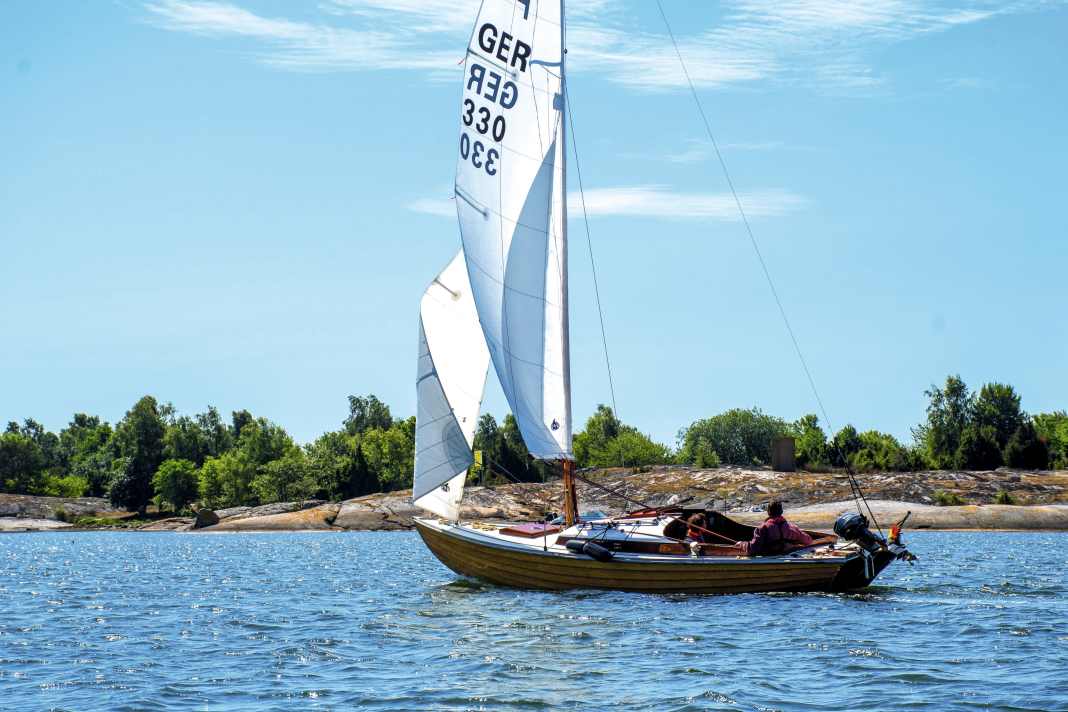



/the-fleet-only-has-one-dinghy-it-is-used-as-a-cable-ferry-at-the-anchorage-near-sturkoe)

Paula" glides reverently with the evening breeze into the shallow bay. Pines, oaks, rocks, red wooden houses - pure Sweden. It must be over there: the Saxemara museum shipyard. A boat builder enthusiastically waves us to a berth, although he only sees one of four folk boats at first. When the entire small flotilla finally arrives in the packet, he can no longer be stopped. He climbs euphorically onto the mast crane and takes photos of the rare visitor. "Sailed all the way here from Germany? How brave!" he exclaims.
I, on the other hand, think that folk boats are ideal for a trip like this, and sailing is per se the most fun in a group with several boats. I have been hiring out "Frieda", "Martha" and "Oliese" on the Schlei for twelve years. When I'm travelling abroad with my "Paula", I simply take the charter boats with me - along with changing crews along the way. This summer trip together has already taken us to the Limfjord, Copenhagen and several times to the Gothenburg archipelago. Now, however, we're exploring new territory: I've never been to southern Sweden and the Blekinge archipelago myself.
We picked up the tip about Saxemara on the way. The museum shipyard has seen better days. Local fishing boats used to be built here in series and wooden boat meetings were held regularly. A cutter lies at depth in the shallow bay and some of the boats on the jetty only look partially afloat. What is in the hall and being restored, on the other hand, indicates solid, conscientiously executed craftsmanship. At least as important: it is fantastically beautiful here!
The journey: From the Schlei across the Småland fairway to Ystad
Our journey began in mid-June. After a light windy start on the Schlei, we made our way through the Småland fairway to Klintholm, followed by an eleven-hour beat across open water to Ystad. From there to Simrishamn, then our actual destination awaits 30 nautical miles further north: Hanö. The island that gives the bay with the Blekinge archipelago its name is a jewel. In the harbour, the resolute harbour master or a patient older gentleman standing in for her assign berths to the yachts. As always, the harbour is full and it is important to keep space free in the tiny harbour for the huge ferry to turn. Is it coincidence or good timing? We get the places I wanted: on the north side of the harbour between the entrance and the ferry dock. They are the only ones that are protected from swell in strong winds from the north-west.
Now, with a southerly wind, "Paula" is drifting squarely towards the thick car tyres that are fendering off the concrete. The neighbours are in a frenzy and want to help, but they don't have to. We put the rudder in hard three times, then we are parallel to the pier and drift gently towards it.
Blekinge, the Pippi Longstocking paradise
Perfume and fresh flowers in the toilets, lovingly tended front gardens - we have arrived in Pippi Longstocking paradise. We treat ourselves to a day in the harbour in beautiful sailing weather. We can't just leave here without an extensive shore leave. The island offers a little bit of everything: rugged rock, barren tundra, mystical forests. Boulder fields mark the different levels at which the sea level has risen over the last ten thousand years. A geological nature trail provides vivid information about what the ice age glaciers caused and what has happened since then. To digest all this, there is also a good fish restaurant in the harbour.
So far it has been 234 nautical miles in nine days. From now on we can enjoy the idyll in short bursts: It's only 30 nautical miles from Hanö directly to Utklippan. In between are the archipelago and Karlskrona, our destination for the crew change. But it's not quite that easy, because in the morning it's blowing at 6 to 7 Beaufort in drizzling rain. Swell runs into the harbour and rocks the large yachts on the west pier.
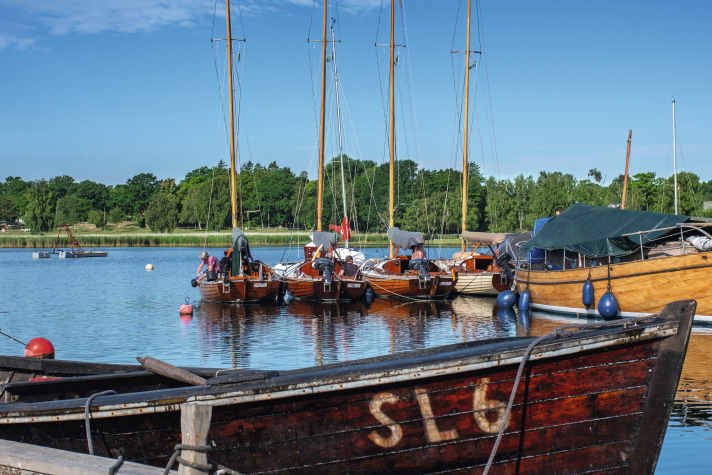
Brave harbour manoeuvre for the start to Tjärö
Brave? Crazy? Or just sensible? Before we tackle the 14 miles to Tjärö, we wait until the wind dies down. But even in westerly winds of five to six, there is only one manoeuvre that takes a small boat with an outboard out of this harbour, and it doesn't involve the engine: it would be dangerous to catch up with it at full tilt. The beach and the stones lurk to leeward - under engine you are always on a lee shore. So set sail at the mooring, pick up speed towards the concrete and after ten seconds make a sharp turn.
The guests are sceptical. Nervous. But also full of confidence. "Frieda" is on the outside of the front packet, she has to be the first to go. She lays on her side and speeds off. Tack, hop-hop, she leaves the harbour and crosses freely. The others are reassured. When "Paula" and I finally set sail, half the harbour has gathered at the bathing pontoon to film and take photos.
The Blekinge archipelago is varied
As soon as we've digested this, the wind gradually dies down and we reach our destination: on Tjärö there is a long jetty at an excursion restaurant and a shorter one directly in the countryside. This is typical of Blekinge: in many places you could moor directly on the rocks in front of the stern anchor, as is common in the Gothenburg archipelago. But there are also jetties almost everywhere, usually with stern moorings, electricity and running water. Of course you have to pay harbour dues, but the good service is worth it. The guests struggle a little with the unfamiliar murings. Once the boats are moored, I take a look around the area - and I'm absolutely thrilled!
I'm a big fan of the western archipelago, while the lovely wooded eastern archipelago reminds me all too much of the Harz Mountains, where I could go every weekend if I wanted to. This here is a successful compromise, further enriched by the beautiful, old summer houses that stand in loose succession on many of the islands. There are signposted footpaths everywhere and a great view awaits around every bend.
Tjärö is explored in one morning. The blackberries are not yet ripe, but the raspberries are delicious. A flock of ducks is feasting on the blueberries, which I disturb a little along the way, as if they have a guilty conscience for picking the fruit away from the humans.
Doldrums in the inland waterway
When the sea breeze sets in in the afternoon, we sail on, nine miles to Saxemara. It takes almost four hours, and that's down to the weather and the area. The archipelago is thin and patchy. In places there is no inner fairway, or it is blocked by a bascule bridge that opens every hour, as off Hallsö. I've had enough of bridge hassle on the Schlei, we sail round the outside.
We will often experience that the day after a strong wind from the south-west, the swell is extremely annoying, sometimes running far into the fjords and taking the pressure off the sails. On light wind days, the thermal breeze extends a little beyond the archipelago, but there is often total calm in the inner fairway. Today it's beautiful sailing for an hour, then I see the paddles being unpacked in front of me. The ripples tell me that the wind is better further out. "Paula" deviates from the briefed route without further ado and passes Stora Ekön to the south across country - watch out for stones! - instead of the buoyed fairway to the north. Works like a charm. "I'm all there," said the hedgehog.
Utklippan, the former pilot station, is an outpost far off the coast - and a favourite stopover for sailors
Four days blown in in Karlskrona
Before the crew change, we spend the night on Norra Bollö at a concrete pier. The uninhabited island is a military training area. If the military were here, we would have to make way. However, like the firing and training areas at sea, we are undisturbed during the summer holidays. And: we finally get to use the stern anchors. Norra Bollö has a completely different character to Hanö, Tjärö or Saxemara on the mainland: there are sheep, geese, bushes, rocks and very few trees here.
The next day, Karlskrona, a strange town. At the end of the 16th century, a naval harbour was initially planned and it was later decided that a settlement was also needed to supply it. This was created, with a chessboard-like layout. The result: the route from the harbour to the supermarket resembles a cross. You have to choose between short stretches or a long one with only one turn at the height of the central square.
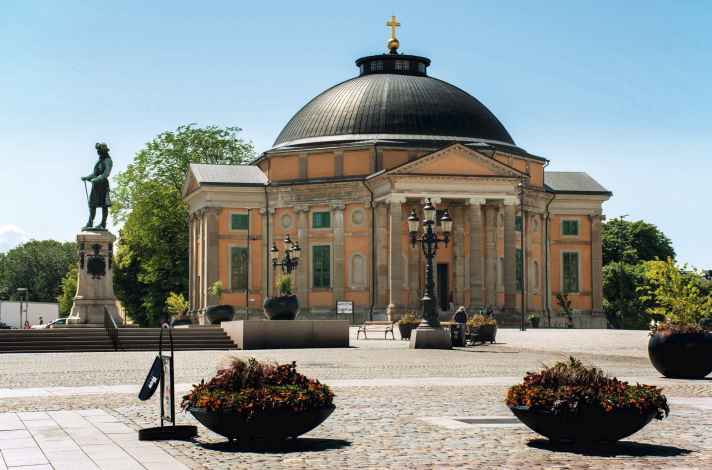
The streets are enormously wide, completely oversized. They are topped by the almost deserted Stortorget, the historic market square, around which two churches and the town hall are grouped. The harbour is also huge, but bearable. There is a railway connection, restaurants and an excellent confectioner. The naval museum is also said to be great.
We stay longer than planned and are buffeted for four days. When we are able to sail again, we speed on through the islands. Finally, the highlight of the trip awaits ahead: Utklippan. The mini-archipelago is an outpost of civilisation, a former pilot station eight nautical miles from the last island we pass. A very special place. The harbour is on the northern island. There is an entrance from the west and an entrance from the east, so that you can always enter the harbour protected from waves. Three rowing boats are ready for the short trip to the south island with its lighthouse, youth hostel and pub. But none of this is in operation. The morbid charm of an abandoned western town hangs over the ensemble.
Utklippan is just a stopover for many
The harbour fills up towards evening. Danish guest country flags indicate that the crews are mainly from Bornholm. Early the next morning, most of them are gone again. Utklippan is a popular stopover to get some sleep on the way to the Göta Canal. But we sail back to the island world of Blekinge. The longest beat of the week, also the one with the least wind, takes us to Tärnö: another dream of an island. Jetty, toilets, everything included.
Once again we fall into the trap of expecting good wind in the inner fairway as well as beautiful scenery. The approach - now again at five knots - is challenging in the backlight of the setting sun. Unfortunately, we don't have enough time to visit the wooden lighthouse at the lookout point. Via Åhus, a great little town on a river estuary with moorings in the lovely Sejlklub, and Kivik, we make our way to Simrishamn for the last crew change of the trip.
Blekinge is doable in five weeks
How good that we have six weeks. If the weather is more favourable, a detour to Bornholm would be feasible, and if you don't waste time with crew changes, you can certainly do Utklippan and back in five weeks. From Rügen, it's all almost on our doorstep, but it's a long way from the Schlei, Kiel or Flensburg.

We still have 180 nautical miles to go on the way back. The forecast promises a persistent westerly wind, always against us, always a little too much. We don't have to go back to the Schlei, just to Svendborg. That's an average of 15 miles per day. Doesn't sound like much, but each day in harbour adds up to 30 miles for the following day. In the face of rough gusts and heavy showers, we manage an impressive six nautical miles in the first four days. Any reason to get nervous?
Small, cosy harbours are lined up along the south coast. This keeps the distances manageable
The guests are experienced, Hannes even sails in the Swiss second league. Sailing in sporting conditions is definitely something they can handle. But the group is just as interested in getting to know Sweden on land. Fortunately, the south coast turns out to be diverse: cosy little harbours are lined up in a loose sequence, each with its own fascination, each worth seeing. Skillinge, for example, attracts visitors with Sandhammaren, a long beach with the finest sand. Kåseberga lies in front of a peculiar cliff, overgrown with grass, here and there a brave shrub and on top - recognisable from the water - a stone circle from the Viking Age. Abbekås, on the other hand, is a pretty club harbour with a great bakery.
Short distances and great scenery in Blekinge
The distances aren't that great, even if you skip towns like Ystad and Trelleborg. After ten miles of cruising, I still feel like I've been exercising. But we are in Smygehuk, the southernmost point of Sweden. The tiny harbour lies in a former limestone quarry. It looks as if the boats are sponging in milk. The view is fantastic: water, vastness, large ships, a wind farm.
And somewhere back there is Møn, where we want to go the next day. But in the west-south-west, that's not going to happen. Luckily there's still Falsterbo. A relaxed 16 nautical miles today, one last day in harbour, then we leave Sweden and sail to Rødvig. We make it to Svendborg, our destination, on time and in high spirits.
Would I include Blekinge in the programme again? Absolutely! It was a varied trip and a great adventure for everyone.
Area information Blekinge
The precinct
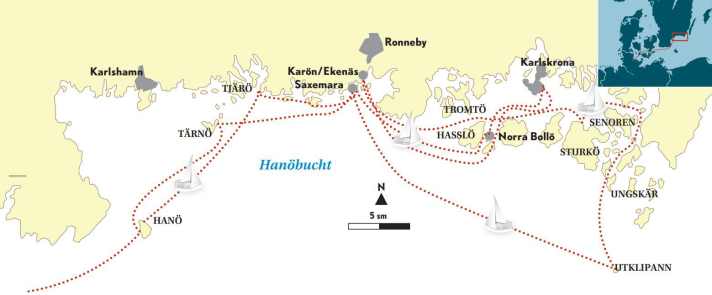
Around 800 archipelago islands longer than 50 metres make up the area, which stretches a good 30 nautical miles from west to east. They are located up to ten nautical miles off the coast. The Gö peninsula in the centre divides the area into the gentler western part and the eastern part, which is dominated by Karlskrona. On its southern edge are the charming, barren outer skerries. The rocks consist of gneiss and granite. The coast is much greener in many places.
Literature & charts
- "Nature and guest harbours in the Blekinge archipelago", an indispensable two-volume guide by Thomas Karlsson. Available in German for approx. 33 euros via PRIVATKONSULT.COM.
- The "Gästhamns Guiden", which is published annually and free of charge in guest harbours, informs sailors about berths and current supply options.
- The DK sports boat chart set 11 with 5 oversailing charts and 34 area and detailed charts covers the area. Price: 129.90 euros, purchase via: SHOP.DELIUS-KLASING.DE
Wind &Weather
The region of Sweden with the mildest climate. The air is at its warmest in July and the water in August. The winds are not constant, even in extreme weather conditions.
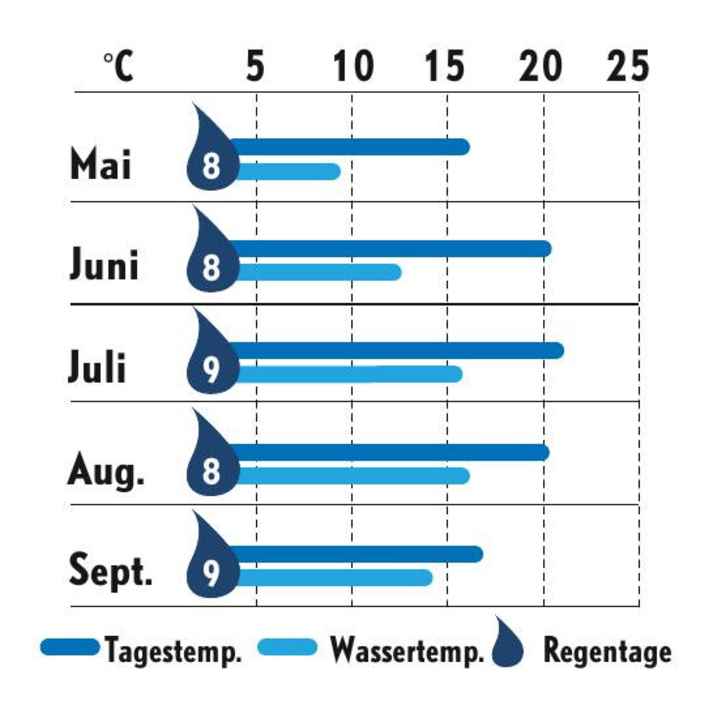
Folkboat charter
Nicolas Thon has been chartering out folk boats in Schleswig on the Schlei since 2012. His Folke fleet currently comprises four boats. They can be hired for individual trips, or you can take part in one of the flotilla trips he organises. This then costs 1,900 euros for a fortnight per boat, excluding travel to and from the destination, food, fuel and harbour fees. Ideally, the boats are sailed in pairs, but single-handed sailors also regularly take part. Further information at: NICOLAS-THON.DE

